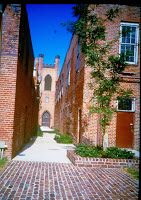Creating a strong sense of community...
 |
| Church Alley after construction was completed |
 |
| Church Alley during construction |
To create a downtown that will attract a diverse concentrated mix of uses and foster economic interaction among these uses, it is essential to encourage people through the downtown core on foot by establishing an attractive system of pedestrian connections. Pedestrian connections create a strong sense of community and walkability, an important goal in New Bern ’s downtown revitalization effort.
According to the summary of existing conditions in the 1977 Downtown Revitalization Plan, pedestrian access from the mid-block parking lots to the shops that fronted Middle, Pollock and Craven streets was inadequate, in some cases dangerous and generally unattractive. To achieve walkability, the 1977 Plan proposed an open space system for the entire redevelopment effort starting at the bulkhead of the urban renewal property along the Trent River and continuing along the Neuse River
The first mid-block pedestrian park, created in 1981 with Municipal Service District (MSD) funds (additional taxes paid by downtown property owners for public improvements) was Bear Plaza
As a result, Church Alley (between Remax and Tom’s Coins), the walkway between First Baptist Church and O. Marks, and the walkway along the Century 21 building from South Front into the interior Federal Alley parking area and the alley between Morgan’s Tavern and the adjacent building were improved to include paving, some with lighting and landscaping. However, a pedestrian connection was still needed on Pollock Street .
In early 1994, when Swiss Bear heard the owner of the old pool hall was considering selling it, with approval from the Municipal Service District Advisory Committee and the city, Swiss Bear board member Stewart Smith approached the owner and worked out an agreement for the city to purchase the building with MSD funds. Acquiring this property was a goal for the creation of a through-block pedestrian linkage onto Pollock Street as recommended in the 1990 Urban Design Plan. This small one-story building was in poor repair, without architectural distinction and its removal would allow a dramatic direct view of the steeple of the Episcopal Church, mirroring the view of the First Baptist through Church Alley.
Swiss Bear hired Allison Platt & Associates to design a plan for the space with plantings, old brick from the streets of New Bern , street lights, benches and a three-tier fountain. Following demolition of the old building by the City, the project was put on hold as the remaining MSD funds were committed for the first phase of major streetscape improvements to the 100/200 blocks of Middle Street.
Swiss Bear met the challenge to move the project forward and worked to raise the needed funds and find an appropriate name for the mid-block pedestrian park. The late Rev. Edward Sharp of Christ Episcopal Church had been a strong supporter of the revitalization effort and Swiss Bear so I asked for his assistance to recommend a name for the park. Through his research efforts, the New Bern Board of Aldermen approved our request to name the park James Reed Lane in memory and honor of this 18th century pioneer in public education. After 230 years, the Rev. James Reed, first rector of Christ Church , received belated public recognition for his role in establishing in New Bern , North Carolina
The city agreed to provide the labor for development of the space and our campaign to raise $60,000 for construction materials, streetlights, benches and planting materials was successful. Additional funding for the beautiful three-tier cast iron fountain was contributed by Dr. and Mrs. Harry MacDonald in honor of his parents, Mr. and Mrs. H.J. MacDonald. John C. Thomas constructed the abstract wood wall hanging and donated the brownstone plaque in the sidewalk that recognizes the MacDonald’s contribution. Contributors to the project are listed on a bronze plaque on the brick wall facing the park.
On Feb. 25, 1996, 2 p.m., the dedication was a joyous well attended occasion. In addition to remarks from Reverend Sharp, the Swiss Bear director and chairman, special guest Patrick Dorsey, North Carolina secretary of Cultural Resources, was the keynote speaker.
Thanks to a public/private partnership that began in the late 1970s, the development of this mid-block pedestrian park added another amenity that enhanced the “walkability and sense of place” of our historic downtown. Downtown now offers a mix of restaurants, retail, galleries, attractions, offices, parks and housing that promote interaction. Since the downtown economy thrives on accessibility, networking, creativity and a sense of community, the numerous pedestrian connections play a vital role as interaction is key to downtown’s success.
Susan Moffat-Thomas
Executive Director of Swiss Bear Downtown Development Corporation.


